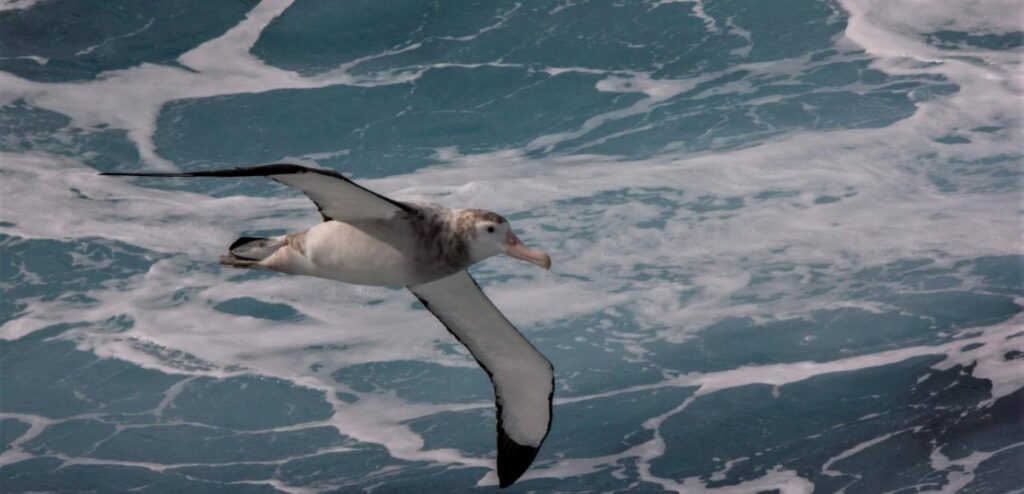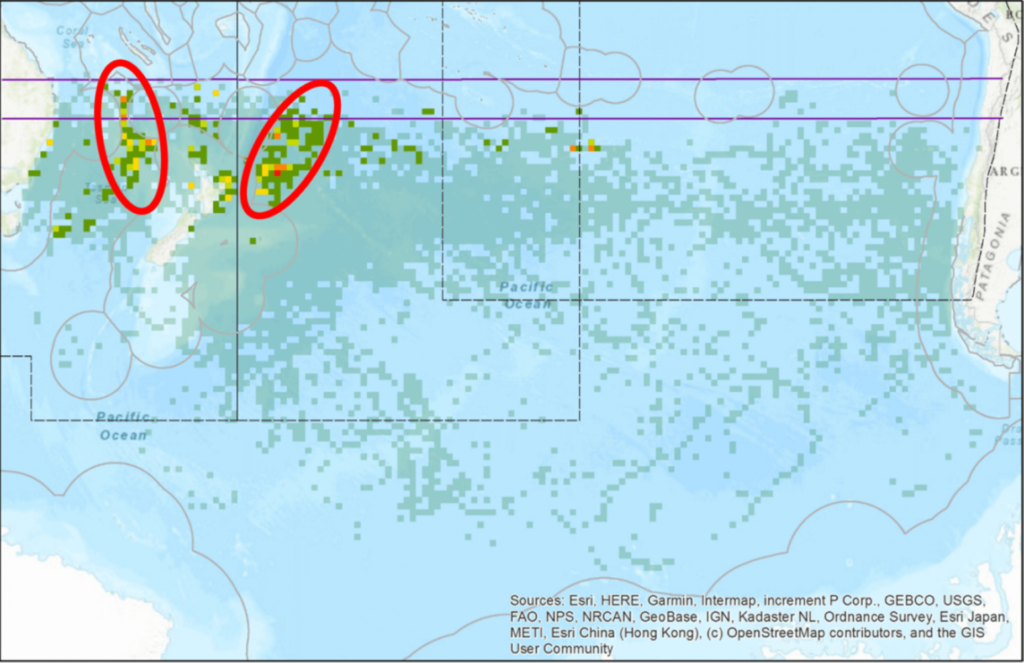New tracking data pinpoints danger zones for Antipodean Albatross

Without action, the Antipodean Albatross could go extinct within our lifetimes. To prevent this tragedy, researchers satellite-tracked 63 albatrosses to discover where they encounter the highest accidental ‘bycatch’ in tuna fishing fleets. Find out how we’re working to make these danger zones safe.
By Stephanie Borrelle, BirdLife Marine & Pacific coordinator
Header image: The Antipodean Albatross travels thousands of miles in search of food © Stephanie Borrelle
With its enormous wingspan and impressive long-distance flying ability, the Antipodean Albatross Diomedea antipodensis seems almost indestructible. But unless we act soon, this majestic ocean wanderer, which breeds on a scattering of islands off New Zealand, could be functionally extinct within 20 years as a result of shockingly high levels of fisheries-related deaths.
This magnificent seabird (a close cousin of the world’s largest flying bird, the Wandering Albatross Diomedea exulans) can live up to 70+ years. Antipodean Albatrosses only start breeding from the age of ten years and, even then, they only lay one egg with each breeding attempt (usually every two years). This slow rate of reproduction makes the species extremely vulnerable to human threats, and in 2018 its conservation status was uplisted to Endangered, as more than half of its breeding population had been lost since 2004.
In an earlier article we described how accidental ‘bycatch’ in longline fisheries is driving their rapid decline in numbers and how, due to the tendency for females to forage in areas with higher density of longline vessels, the remaining population suffers from a skewed sex ratio with two males for every one female.
To discover more, in 2019 researchers fitted satellite transmitters to 63 Antipodean Albatrosses, and tracked them for up to 12 months. During this time, eight transmitters stopped working close to fishing vessels, and one transmitter was later recovered from a bird caught by a high seas longline vessel fishing out of American Samoa.
When researchers overlaid this tracking data with the distributions of longline fishing boats, they found that the areas of greatest overlap took place in the High Seas of the Western Pacific Ocean, particularly in the mid-Tasman Sea and to the northeast of New Zealand. When this tracking information was split by flag state, it revealed several key fishing fleets operating in areas frequented by the species, including Taiwan, Vanuatu (although vessels are likely operated by companies in Taiwan or China), New Zealand, China, and Spain.

This information is vital in informing where efforts to reduce seabird bycatch should be targeted. The New Zealand government has already been engaging the fishing industry, both nationally and through international diplomatic channels, to make sure mitigation measures (such as bird-scaring lines, weighted fishing lines, hook protection devices and setting the fishing lines at night) are being used in these high-risk areas. They have also recently introduced regulations requiring on-board cameras on commercial vessels fishing in New Zealand’s Exclusive Economic Zone to the west of North Island. These regulations will be rolled out further in 2021, and aim to increase onboard monitoring to ensure compliance with mitigation measures.
Addressing other fleets in the High Seas will require working with the relevant tuna Regional Fisheries Management Organisations, or RFMOs, who control the rules relating to tuna fishing around the world. We will need to push for the strengthening of existing regulations which require the use of mitigation measures in areas of the ocean where seabird bycatch risk is high.
BirdLife continues to work with other conservation NGOs to advocate for greater protection for seabirds in these areas. For example, the Western and Central Pacific Fisheries Commission (WCPFC) has jurisdiction over tuna fisheries management in the Antipodean Albatross’ range. Here, we advocate for an increase in observer coverage on boats – from 5% (a level that has not changed for over a decade) to 100%. Greater observer coverage has been shown to dramatically improve compliance with seabird bycatch mitigation measures. This work is challenging, however. In the absence of a comprehensive system of independent observation, current regulations are already difficult to monitor and enforce.
Another approach that BirdLife has adopted is to speak to vessel owners as they enter ports across the Pacific. Already in Fiji, BirdLife Pacific run a port-based outreach program where a local Fijian is employed to talk to fishers about seabird bycatch regulations. There is even a local women’s+ group who are making bird-scaring lines for vessels coming into Fiji’s ports. This work has resulted in increased awareness among the crews of vessels arriving in Suva’s port. They are now far better informed about their obligations under the RFMOs, and importantly, the plight of the Antipodean Albatross.
However, without urgent action from the fishing industry and WCPFC, the future of the Antipodean Albatross becomes increasingly precarious. If we want this majestic species to continue inspiring future generations, we need to halt needless deaths in commercial fisheries.
So what can you do for this emblematic bird? Market pressure is one of the most powerful ways to change commercial practices. Choosing tuna that is MSC-certified, and asking restaurants where the tuna they serve is caught and whether it is sustainably sourced, is one step in the right direction. When the demand for responsibly-sourced, seabird-friendly seafood increases, companies will be compelled to respond.
Stay up to date
Sign up to receive the latest bird conservation news. You’ll also receive updates about our projects, science and other ways to get involved including fundraising.
Thank you for your support, we are committed to protecting your personal information and privacy. For more information on how we use your data, please see our Privacy Policy. You can unsubscribe from emails at any time by using the link in the footer of any email from us.

